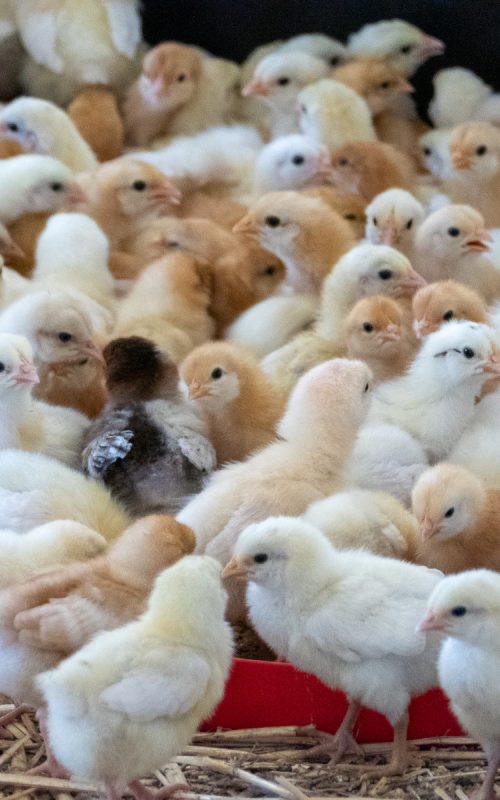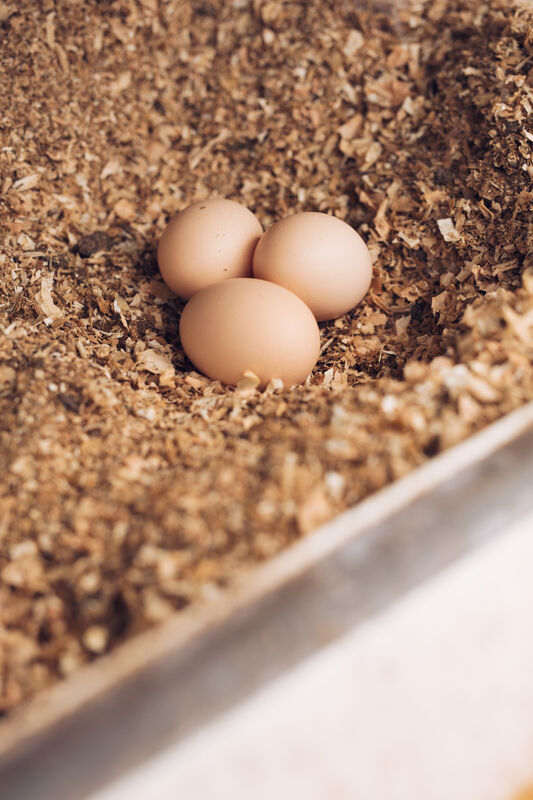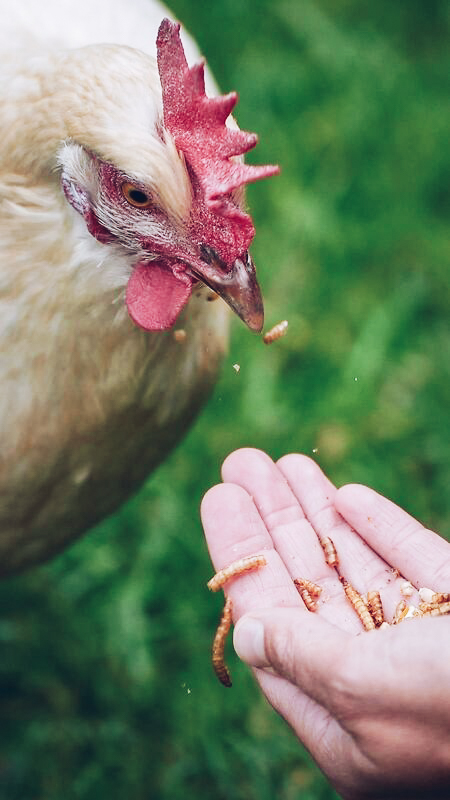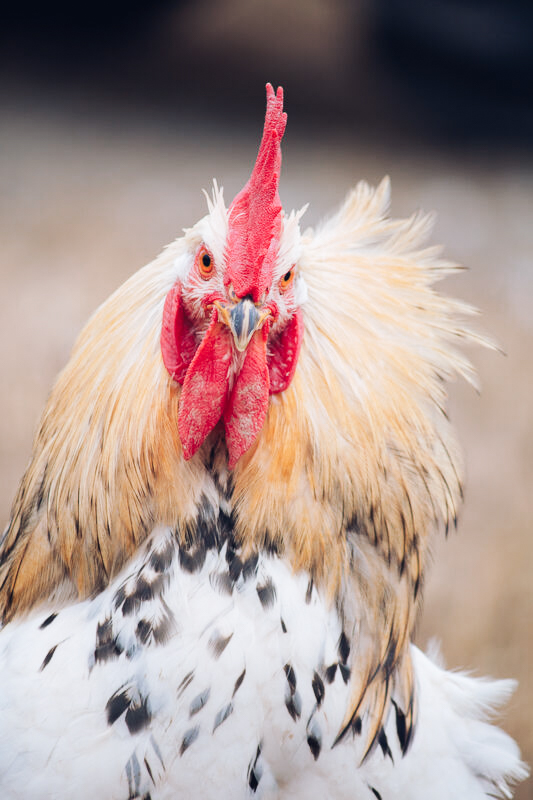Breeding is a never-ending, ongoing process and new challenges and questions arise with every generation. The search for answers is best achieved through constant networking and exchange with research institutes, universities, advisory organizations and agricultural practitioners - both nationally and internationally.
Without the cooperation of a large number of committed researchers and the financial support of the federal government (Federal Organic Farming Program), the federal states and private foundations, our work would not be possible in this form - then as now.

This project is funded by the Federal Ministry of Agriculture, Food and Regional Identity as part of the Federal Organic Farming Programme.
Dual-purpose chickenDas Zweinutzungshuhn bezeichnet Zuchtlinien, die sowohl für die Eierproduktion als auch für die Fleischgewinnung geeignet sind. Im Gegensatz zu spezialisierten Hochleistungstieren – bei denen entweder auf hohe Legeleistung (Legehennen) oder schnelles Fleischwachstum (Masthähnchen) gezüchtet werden – bietet das Zweinutzungshuhn eine Möglichkeit beide Eigenschaften in einem Tier zu vereinen. Da jedoch keine Spezialisierung vorliegt, sind die Leistungen bei Ei und Fleisch ausgeglichen und in der Regel etwas geringer, als die Leistungen von spezialisierten Tieren. in organic agriculture - Breeding and potential identification of suitable origins and implementation in practice.
Since 2017, the Federal Ministry of Agriculture, Food and Regional Identity has been promoting the development of organic poultry breeding programme in Germany as part of the Federal Organic Agriculture Program.
The far-reaching problems of one-sided conventional basic breeding have been recognized and the dual-purpose approach of chickens in organic farming has been intensively promoted. In the two projects ÖkoHuhn (2017-2019) and Öko2Huhn (2020-2026), the diverse production structures and demands of the industry are reflected in the development of various cross breedings of dual-purpose chickenDas Zweinutzungshuhn bezeichnet Zuchtlinien, die sowohl für die Eierproduktion als auch für die Fleischgewinnung geeignet sind. Im Gegensatz zu spezialisierten Hochleistungstieren – bei denen entweder auf hohe Legeleistung (Legehennen) oder schnelles Fleischwachstum (Masthähnchen) gezüchtet werden – bietet das Zweinutzungshuhn eine Möglichkeit beide Eigenschaften in einem Tier zu vereinen. Da jedoch keine Spezialisierung vorliegt, sind die Leistungen bei Ei und Fleisch ausgeglichen und in der Regel etwas geringer, als die Leistungen von spezialisierten Tieren. In the project networks, we look at the different approaches with pure breed chickens, crossbreeds and hybrids.
In the ongoing Öko2Huhn project, we are working on various issues relating to our breeding program and the purebred lines Bresse Gauloise, New Hampshire and White Rock. The breeding site in Goch has also been continuously developed in the projects.
In other parts of the project, the University for Sustainable Development in Eberswalde is conducting origin comparisons on farms nationwide and trials to optimize the management of dual-purpose chickens. Recurring problems and the effectiveness of measures are being investigated.
Another part of the project of the University of Hohenheim and the Weihenstephan-Triesdorf University of Applied Sciences deals with the development of a vital breeding population of Sundheim chickens for organic farming and the transfer into practice. A mobile barn for performance testing and mating chickens under organic conditions was developed to strengthen farm breeding structures. In the six separate compartments with their own exercise areas, the laying performance can now be recorded for each individual animal.
Contact for this project:
Elias Schmelzer | elias.schmelzer@bioland-beratung.de
A project that aims to establish and coordinate regional marketing cooperations and international marketing chains for hatching eggs, day-old chicks and pullets from organic breeding.
As part of the three-year project, which started in September 2023, ÖTZ wants to develop concepts in cooperation with its partner hatcheries to strengthen sales of hatching eggs, day-old chicks and pullets. The focus here is on strengthening regional distribution channels, but national and international supply chains are also to be supported and further developed.
One of the project objectives is to establish a joint marketing platform that provides a regional, flexible, administratively low-threshold and efficient procurement of ÖTZ young animals and, if farmers are interested, enables an optional interface to other ÖTZ services such as advice, consumer information and marketing support. Another goal is to further develop the ordering and delivery management system in order to increase the predictability for the farms and to implement a quality management system to further develop the quality of the animals delivered (weight, uniformity and health status). An additional focus is on customer management. The aim is to continuously increase customer satisfaction and to analyze and eliminate current reasons for complaints.
In cooperation with the regional partner hatcheries, at least 200,000 ÖTZ eggs per year should be hatched and distributed regionally by the end of the project if all aspects of the project are successfully implemented. A similar figure is expected for national, centralized distribution via the Hockenberger hatchery, one of the cooperation partners.
The project is being carried out as part of funding for organic value chains under the Federal Program for Organic Farming and Other Forms of Sustainable Agriculture (BÖLN).
For more information and if you have any questions, please contact us: info@oekotierzucht.de

This project is funded by the Federal Ministry of Agriculture, Food and Regional Identity as part of the Federal Organic Farming Programme.

This project is funded by the Federal Ministry of Agriculture, Food and Regional Identity as part of the Federal Organic Farming Programme.
Ökologische Tierzucht gGmbH (ÖTZ) is part of the consortium which, in the project “sLowFeedChickIns - Optimized nutrient supply of dual-purpose chickens - Adapted rations, alternative protein sources, effects and adaptation options”, aims to show new ways of optimizing the rearing of dual-purpose chickens with regard to regional raw material procurement, reduced competition with human nutrition and the origin of protein components.
The project is funded as part of the “Announcement on the funding of research and development projects to secure sustainable nutrition for farm animals under changing climatic conditions” of the Federal Ministry of Agriculture, Food and Regional Identity (BMLEH) and will run for four years. It is being carried out in cooperation with the University of Veterinary Medicine Hannover Foundation (Institute of Animal Nutrition), the Eberswalde University for Sustainable Development (Department of Organic Animal Husbandry), the Thünen Institute (Institute of Organic Farming), the Leibniz Institute for Agricultural Engineering and Bioeconomy and Bioland Beratung, which is coordinating the project together with ÖTZ. The basic assumption of the project is that
The basic assumption and working hypothesis of the project is, that Dual-purpose chickenDas Zweinutzungshuhn bezeichnet Zuchtlinien, die sowohl für die Eierproduktion als auch für die Fleischgewinnung geeignet sind. Im Gegensatz zu spezialisierten Hochleistungstieren – bei denen entweder auf hohe Legeleistung (Legehennen) oder schnelles Fleischwachstum (Masthähnchen) gezüchtet werden – bietet das Zweinutzungshuhn eine Möglichkeit beide Eigenschaften in einem Tier zu vereinen. Da jedoch keine Spezialisierung vorliegt, sind die Leistungen bei Ei und Fleisch ausgeglichen und in der Regel etwas geringer, als die Leistungen von spezialisierten Tieren. show a higher tolerance with regard to feed components and nutrient density and will show a higher overall resilience to climate change and the associated temperature changes due to their lower metabolic activity.
The aim is to investigate the extent to which the protein density currently recommended in organic farming can be gradually reduced and, in a second step, to what extent emission-sensitive protein components such as soy or sunflower press cake can be replaced by various insects and macroalgae, while at the same time optimizing the protein matrix for poultry feed.
The experiments are carried out in small groups as part of selective experiments and subsequently in practice-relevant flock sizes, both in relation to laying hens and fattening animals.
In addition, various tests are being carried out to shed light on the feed safety of the components used and to demonstrate the climate-neutral potential of producing the alternative protein sources.
The project and the project results focus strongly on feasibility in current agricultural practice and the project team is therefore in close contact with feed mills, farms and manufacturers of feed components on an ongoing basis. The bottom line is to develop feed mixtures that guarantee an optimal nutrient supply with maximum use of regional components and, due to the high use of material by-products, represent as little competition as possible with human nutrition.
Contact for further information, please contact Inga Günther-Bender (project leadership): inga.guenther-bender@oekotierzucht.de
Securing horn-bearing cattle breeding, cow family breeding and old breeds
A new project on organic cattle breeding funded by the Software AG Foundation began on February 1, 2024. In addition to Ökologische Tierzucht gGmbH, Demeter Beratung e.V., the Demeter Landesverband Bayern, the Gesellschaft zur Erhaltung alter und bedrohter Haustierrassen (GEH) and Demeter im Norden are involved in the project. For a period of 5 years, this project will make it possible for the first time to firmly integrate specific content on cattle breeding into the advisory activities of the participating project partners.
Securing horned cattle breeding
The key to securing the breeding of horned cattle is the activation and networking of farms with each other and the simultaneous support of farms in these activities through advice. The cross-association network of farms that actively breed cattle with horns, which was established in the course of previous projects, is to be further expanded. To this end, the existing website hornkuh.de will be revised in the near future and the farm database and presentation located there will be given greater focus. Existing advisory services (e.g. the targeted bull recommendation lists of the ÖTZ, support in the management of horn-bearing herds) are to be expanded and further developed and closely coordinated with the content on cow family breeding.
Cow family breeding as a suitable breeding method is particularly interesting for farms that want to work with natural breeding. The project aims to get new farms interested in cow family breeding, provide advisory support and improve the networking of farms that already use the method.
In the coming years, the cooperation with GEH will be used to develop a targeted support for farms that work with old and endangered breedsshall be reached.
We can support project farms in the following areas: Mating advice, selection of breeding animals, management recommendations for challenges in keeping horn-bearing herds, calculation of inbreeding coefficients, triple-A.
In addition to targeted, farm-specific advice, we want to strengthen the networking of farms through events and the establishment of regional working groups.
Contact for this project: Mabelle Tacke: mabelle.tacke@oekotierzucht.de

This project is funded by Software AG Stiftung

This project is funded by the Federal Ministry of Agriculture, Food and Regional Identity as part of the Federal Organic Farming Programme.
Bio-Nutzkälber in die Bio-Wertschöpfungskette integrieren
Ein Projekt zur Stärkung der ökologischen Verwertung von Milchviehkälbern durch neue Wertschöpfungsketten, bessere Vernetzung und konkrete Unterstützungsstrukturen.
Seit Januar 2025 läuft das auf drei Jahre angelegte Projekt „WSNuKa“, mit dem Ziel, die Situation von Bio-Milchkälbern, die nicht zur Remontierung genutzt werden, strukturell zu verbessern. Aktuell verlassen viele dieser Kälber die ökologische Wertschöpfungskette – häufig aus ökonomischen Gründen. Gemeinsam mit Partnern aus Landwirtschaft, Verarbeitung, Handel und Beratung will die ÖTZ neue Wege aufzeigen, wie diese Kälber nachhaltig und wirtschaftlich sinnvoll aufgezogen und vermarktet werden können.
Kern des Projekts ist der Aufbau einer Koordinationsstelle, die als Schnittstelle zwischen Praxis, Vermarktung und Strukturentwicklung fungiert.
Ziel ist es, bestehende Lösungsansätze zu analysieren, neue Netzwerke und Vermarktungsformen zu initiieren sowie praxisnahe Instrumente zu entwickeln – wie etwa eine Zertifizierung mit Siegel für die ökologische Kälberaufzucht und -vermarktung.
Ein besonderer Fokus liegt auf dem Wissenstransfer und der Vernetzung: Workshops, Befragungen, Vernetzungstreffen und Öffentlichkeitsarbeit sollen alle Akteur:innen der Bio-Wertschöpfungskette zusammenbringen und langfristige Kooperationen ermöglichen. Neben den Kooperationspartnern Bioland Standards Niedersachsen/Bremen, Demeter im Norden und der Brudertier Initiative (BID) begleiten zwei landwirtschaftliche Betriebe (Meedehof and Hof HimP), eine Schlachterei (Elbtaler Hofschlachterei) und ein Online-Händler (besserfleisch) das Projekt als Pilotpartner.
Ansprechpartnerin und Wertschöpfungskettenmanagerin im Projekt ist May-Britt Wilkens: may.wilkens@oekotierzucht.de
Why is/was the WerterHahn project important?
In principle, the organic chicken market focuses heavily on egg production, i.e. laying hens, while poultry meat, especially that from the brothers of layer hens and dual-purpose cocks, has difficulty finding its way onto the market. One of the main reasons for this is the fattening performance of these roosters, which is considerably lower than that of specialized fattening lines, as well as the special meat quality of these roosters. The WerterHahn project was therefore launched in 2022 with the aim of developing a nationwide but regionally structured value chain for these organically produced brother and dual-purpose cockerels. By networking breeding, agriculture, processing, trade and gastronomy, existing structures were to be expanded and new marketing channels established. This networking should be based on a digital platform where supply and demand meet.
What were the specific measures in the project?
Together with the Brudertier Initiative Deutschland e.V. and Bauckhof GmbH, a WerterHahn coordination office was created in 2021. This office is located and managed by ÖTZ. Since then, Maria Herrmann and Joachim Jeske have been working as value chain managers in the project to network the players along various supply chains. One of the first measures was a status quo survey of agricultural and processing businesses. The results showed that around 80% of the farms have focused their sales on direct marketing from the farm. This applies to both the Cock meatDual-purpose cockerel production refers to a concept in poultry farming in which the male chicks of dual-purpose chicken are reared to be used as a source of meat. In dual-purpose chicken production, the cocks grow up more slowly and reach a lower carcass weight compared to specialized broilers. The meat from these animals is considered to be of particularly high quality, aromatic and tasty. and the eggs. In order to expand the marketing opportunities of the individual farms based on this knowledge, the next step was to test the cooperation with the operator of a portal as a digital farm store. Our experiences so far in this test illustrate how important and challenging the daily maintenance of data in such a system is. Only if this is successful on the individual farms in day-to-day business can stable and long-term functioning marketing structures be created.
Activities have been expanded to include other players in the marketing chain. These included the ÖTZ Expert Forum, trade training courses in cooperation with the Natural Food Education Network (Binako) and at wholesale and organic trade fairs. Individual information and training offers were created.
What are the findings from the work so far?
The biggest challenge remains to create a continuous sales market. Here we are dependent on the will and support of all players along the value chain. The regional and local infrastructure for processing and marketing cock meat, which varies greatly in some cases, as well as the severe pressure on market prices, show that a digital platform, as originally planned, cannot close the gaps.
Even if individual sub-projects - e.g. the addition of Bruder and ÖTZ cock meat to organic chicken nuggets from 2026 onwards - have emerged from the WerteHahn project, the challenges for the future remain great.
What do we need to do next?
The project ends on December 31, 2024, as the funding expires. For the ÖTZ, our partners and sponsors, however, it remains a matter of concern to lead the Bruderhahn out of its thankless role in the production of poultry meat. Even though ÖTZ's breeding work is not aimed at breeding “broiler chickens” for the mass market, we will continue to work on offering the market a balanced rooster. The aim remains animal welfare, sustainable ecological circular economy,Kreislaufwirtschaft im landwirtschaftlichen Betriebskontext bezeichnet ein nachhaltiges Bewirtschaftungssystem, das darauf abzielt, natürliche Ressourcen effizient zu nutzen, Abfall zu minimieren und Stoffkreisläufe innerhalb des Betriebs zu schließen. Dabei werden Nährstoffe und Energie im Betrieb gehalten, um Abhängigkeiten von externen Ressourcen zu verringern und die Umweltbelastung zu reduzieren. Kernprinzipien der Kreislaufwirtschaft in der Landwirtschaft: Nährstoffkreisläufe schließen: Organische Abfälle wie Mist, Gülle oder Pflanzenreste werden zu Dünger (z. B. Kompost) verarbeitet und wieder auf die Felder ausgebracht, um den Boden zu nähren. Ressourceneffizienz: Wasser, Energie und Boden werden so genutzt, dass Verluste minimiert werden, z. B. durch Regenwassersammlung oder erneuerbare Energien. Diversität fördern: Der Anbau verschiedener Kulturen und die Haltung unterschiedlicher Tierarten verbessern die Ressourcennutzung und fördern die Bodenfruchtbarkeit. Wiederverwertung: Nebenprodukte eines Produktionszweigs (z. B. Stroh aus der Getreideproduktion) werden für andere Zwecke genutzt, etwa als Tierfutter, Einstreu oder Biomasse. Regenerative Praktiken: Maßnahmen wie Humusaufbau und Agroforstwirtschaft binden CO₂, fördern die Bodenfruchtbarkeit und schützen das Ökosystem. Ziele der Kreislaufwirtschaft in der Landwirtschaft: Verbesserung der Bodenqualität und Förderung der Biodiversität. Reduzierung von Abfall, beispielsweise durch Nutzung organischer Reste. Verringerung der Abhängigkeit von chemischen Düngemitteln und fossilen Brennstoffen. Förderung eines resilienten, langfristig tragfähigen Betriebssystems. Dieser Ansatz unterstützt eine nachhaltige Landwirtschaft, die im Einklang mit natürlichen Prozessen arbeitet und zugleich wirtschaftlich tragfähig bleibt. and a tasty product.
Contact person for this project: Joachim Jeske joachim.jeske@oekotierzucht.de

This project has been funded by the Federal Ministry of Food an Agriculture (BMEL) as part of the Federal Program for Organic Agriculture.
Since 2025, the BMEL is called the Federal Ministry of Agriculture, Food and Regional Identity (BMLEH).
OETZ10
Die Aktion gilt nur für Lieferungen bis zum 20.09.2025
You need to load content from reCAPTCHA to submit the form. Please note that doing so will share data with third-party providers.
More InformationYou are currently viewing a placeholder content from Google Maps. To access the actual content, click the button below. Please note that doing so will share data with third-party providers.
More Information